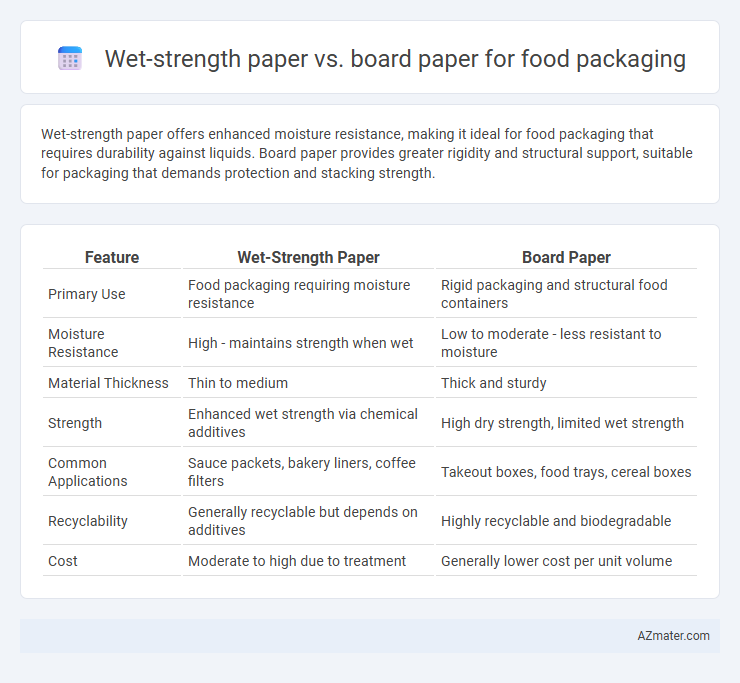Wet-strength paper offers enhanced moisture resistance, making it ideal for food packaging that requires durability against liquids. Board paper provides greater rigidity and structural support, suitable for packaging that demands protection and stacking strength.
Table of Comparison
| Feature | Wet-Strength Paper | Board Paper |
|---|---|---|
| Primary Use | Food packaging requiring moisture resistance | Rigid packaging and structural food containers |
| Moisture Resistance | High - maintains strength when wet | Low to moderate - less resistant to moisture |
| Material Thickness | Thin to medium | Thick and sturdy |
| Strength | Enhanced wet strength via chemical additives | High dry strength, limited wet strength |
| Common Applications | Sauce packets, bakery liners, coffee filters | Takeout boxes, food trays, cereal boxes |
| Recyclability | Generally recyclable but depends on additives | Highly recyclable and biodegradable |
| Cost | Moderate to high due to treatment | Generally lower cost per unit volume |
Introduction: Understanding Food Packaging Materials
Wet-strength paper offers enhanced durability and resistance to moisture, making it ideal for food packaging that requires protection against liquids and steam. Board paper, typically thicker and more rigid, provides excellent structural support and cushioning, suitable for packaging heavier or bulkier food items. Choosing between wet-strength paper and board paper depends on the specific food product's moisture exposure and packaging strength requirements.
What is Wet-Strength Paper?
Wet-strength paper is specially treated with wet-strength resins like polyamide-epichlorohydrin to retain durability and integrity when exposed to moisture, crucial for food packaging applications where contact with liquids is common. Unlike standard board paper, which loses strength and becomes prone to tearing or breaking when wet, wet-strength paper maintains its mechanical properties, ensuring reliable protection and containment of moist or greasy food products. Its enhanced resistance to water absorption makes it ideal for packaging items such as takeaway containers, food wraps, and bakery bags.
Key Features of Board Paper
Board paper for food packaging offers superior rigidity and thickness compared to wet-strength paper, providing excellent protection and structural support for heavy or fragile food items. It features enhanced moisture resistance through coatings or lamination, making it suitable for packaging greasy or moist foods without compromising integrity. The high printability and customizable surface treatments of board paper also allow for attractive branding and labeling, essential for consumer appeal and regulatory requirements.
Manufacturing Process Comparison
Wet-strength paper utilizes resin additives such as polyamide-epichlorohydrin (PAE) during the pulping stage to enhance water resistance by chemically bonding fibers, enabling it to maintain integrity under moist conditions. Board paper, typically thicker and stiffer, is manufactured through a multi-ply lamination process where layers of pulp are compressed and dried to achieve rigidity and durability suited for structural packaging. The specialized wet-strength treatment in wet-strength paper requires precise resin application and curing steps, contrasting with the layering and calendering techniques emphasized in board paper production for optimal stiffness and printability in food packaging.
Moisture Resistance: Wet-Strength Paper vs Board Paper
Wet-strength paper features chemically reinforced fibers that maintain integrity and resist disintegration when exposed to moisture, making it ideal for packaging greasy or liquid-containing foods. In contrast, board paper typically exhibits lower moisture resistance due to its thicker, less treated composition, which may lead to weakening or deformation under high humidity or wet conditions. Selecting wet-strength paper enhances durability and preservation by preventing absorption and maintaining packaging structure in moist food environments.
Durability and Structural Integrity
Wet-strength paper exhibits enhanced durability and structural integrity under high moisture conditions, making it ideal for food packaging that involves exposure to liquids or steam. Board paper, while generally thicker and more rigid, may lose strength when wet, compromising its performance in packaging applications requiring prolonged moisture resistance. Selecting wet-strength paper ensures reliable protection and maintains package integrity, crucial for preserving food quality and safety during distribution and storage.
Sustainability and Recyclability Considerations
Wet-strength paper used in food packaging incorporates chemical additives that enhance durability in moist conditions but complicate recycling processes due to reduced fiber recovery and potential environmental contamination. Board paper, particularly kraft board, offers superior sustainability by utilizing unbleached fibers and minimal additives, resulting in easier recyclability and better biodegradability. Selecting board paper over wet-strength variants supports circular economy goals by promoting higher recycling rates and lower ecological impact in food packaging applications.
Cost Efficiency in Food Packaging
Wet-strength paper offers enhanced durability in moist environments, reducing the need for additional protective coatings, which can lower overall packaging costs. Board paper, while generally less expensive upfront, may require supplementary treatments or lamination to maintain integrity with wet or oily foods, increasing total expenses. Choosing wet-strength paper can improve cost efficiency by minimizing product damage and packaging waste in food packaging applications.
Common Applications in the Food Industry
Wet-strength paper is commonly used for food packaging requiring moisture resistance, such as bakery bags, frozen food wraps, and takeaway containers, ensuring durability and maintaining integrity when exposed to liquids. Board paper, including folding cartons and rigid boxes, is preferred for packaging dry or semi-dry foods like cereals, confectionery, and fresh produce, offering structural support and printability for branding. Both materials are chosen based on the specific food product's moisture content and handling needs within the food industry.
Choosing the Right Material for Food Packaging Needs
Wet-strength paper offers excellent moisture resistance, making it ideal for packaging moist or greasy foods such as takeout containers and bakery wraps. Board paper, characterized by its rigidity and thickness, provides superior protection and structural support for heavier or dry food products like cereal boxes and frozen food cartons. Selecting the right material depends on the specific food type, with wet-strength paper enhancing durability against water exposure, while board paper ensures impact resistance and maintains product integrity during transportation.

Infographic: Wet-strength paper vs Board paper for Food packaging
 azmater.com
azmater.com